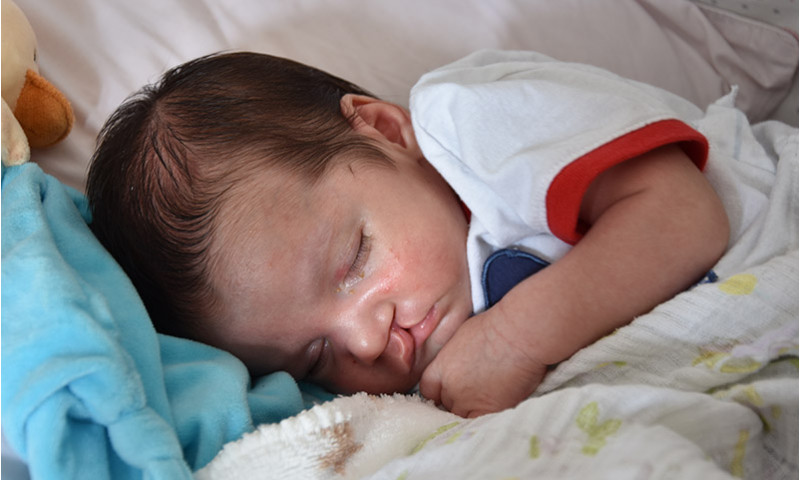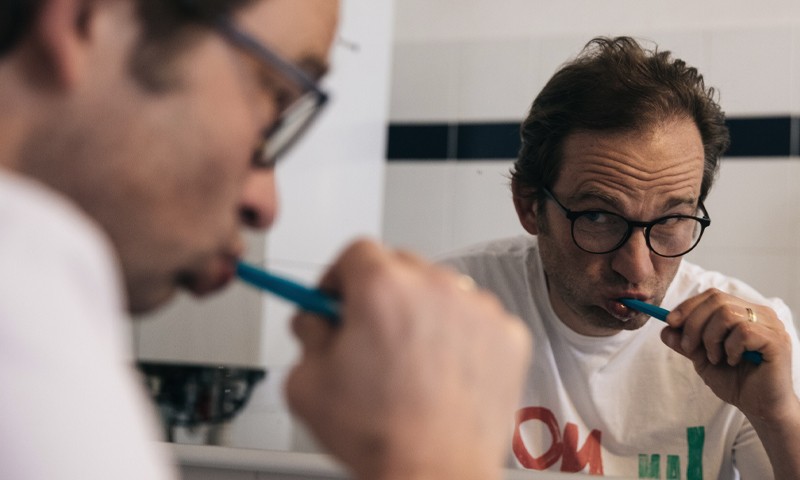Definition: What is cleft lip and palate?
Cleft lip and palate – colloquially often referred to as a "harelip" – is one of the most common congenital malformations. Discover below why the term "harelip" should no longer be used. In Europe, about one in every 500 babies is born with this oral birth defect. Important to know: Not all three areas are always simultaneously affected. There are malformations that only affect the lip and jaw or only the palate. However, all malformations within these oral areas are collectively categorised as "cleft lip and palate".
More than 50 per cent of those affected exhibit cleft lip with cleft palate, thereby encompassing both defects. In this case, there is an incomplete or complete cleft, or gap, in the upper lip and the hard or soft roof of the mouth (palate).
The malformation is usually picked up during a pregnancy scan – or is diagnosed after birth.
As the name suggests, a cleft is the main characteristic of this defect when a baby's lip or mouth do not form properly. It can occur on one or both sides of the lip or even in the middle. There are four sections in the classification of clefts:
- Lip (upper lip plus nasal vestibule)
- Jaw (tooth-bearing part of the upper jaw – the alveolar crest)
- Hard palate (roof of the mouth with sinus floor)
- Soft palate (rear edge of the hard palate up to the uvula)
Why you should no longer say "harelip"
Many people still say "harelip" when referring to cleft lip and palate. However, the term has little to do with the anatomy of an animal.
In the past, this term was considered acceptable to describe cleft lip and palate. Unfortunately, this derogatory term is still used to this day – even by medical professionals. It is, however, often considered discriminatory by those affected by the deformation and it is advisable to refrain from using it.
The origin of the term is not entirely clear or documented. One theory is that cleft lip and palate visually resembles the Y-shaped cleft of the upper lip up to the nostrils of a hare.
In this context, it is also interesting to note that for centuries in Europe, as well as in Asian and Anglo-Saxon cultures, there was a belief that encountering a hare, craving hare meat or even thinking of a hare during pregnancy could lead to a baby being born with a cleft.
Which cleft forms exist?
Depending on when the facial defect occurred during pregnancy, various forms of the malformation can develop. There are more than 100. They are distinguished based on their place of origin and the degree of their manifestation. In summary, the following cleft types exist:
Incomplete cleft lip
There is a slight notch in the upper lip. The lip failed to join completely before birth. However, the cleft does not extend to the nostril.
Complete cleft lip
There is a complete separation that extends from the upper lip to the nose. Sufferers can also have a bilateral cleft condition, where both sides of the mouth are affected.
Complete cleft lip and palate
In this case, the lip and the tooth-bearing part of the upper jaw are affected. The notch runs along the edge of the philtrum (the philtral dimple between the nose and the mouth) in the upper lip and along the lateral incisor of the upper jaw.
Incomplete cleft palate
An incomplete cleft palate occurs in 30 per cent of all cases. In this category, as the name suggests, the palate is only partially affected.
Complete cleft palate (cleft of the hard and soft palate)
In the case of a complete cleft palate (cleft of the hard and soft palate), the cleft involves the entire palate. Both the hard front part and the soft back part are affected. Incomplete clefts of the soft palate also exist. However, there are no incomplete clefts of the hard palate.
Simple explanation: How do clefts form
Many parents ask: When does cleft lip and palate develop? To answer this question, we need to take a look at how a baby's face develops in the womb. This development step starts in the early weeks of pregnancy. Individual parts of the face develop separately at first before joining together.
The two halves of the nasal area and the upper lip or upper jaw come together between the fifth and seventh weeks of pregnancy. Shortly afterwards – around the tenth week of pregnancy – the upper lip, the front jaw section and the soft and hard palate are joined together. If joining is incomplete during one of these development steps before birth, a cleft may develop.
Causes of cleft lip and palate
The exact reason why problems sometimes occur when the face is developing is often unclear. But what we do know: There is no one factor that causes the malformation. Cleft lip and palate is usually the result of several circumstances. Firstly, the genes a child inherits from their parents play a role: In up to 40 per cent of cases, cleft lip and palate is inherited (mostly recessive inheritance).
Are you about to become a parent, or would you like to become one – and has a child in your family been affected by cleft lip and palate? In this case, genetic counselling might be beneficial in determining the individual risk for your baby.
Risk factors
In addition to genetic causes, other external risk factors during pregnancy can contribute to the development of cleft lip and palate. We have summarised them below:
- Drinking alcohol
- Smoking
- Taking drugs
- High amounts of vitamin E and A
- Stress
- Underlying health conditions
- Lack of folic acid
- Acute diseases such as rubella
- Restricted flow of oxygen to the unborn child
- Fever
- Exposure to radiation
- Exposure to toxins
- Taking certain medicines, like antiepileptic drugs
As stated above, development of a baby's face takes place in early pregnancy. Experts therefore recommend that women who want to have children exclude the aforesaid risk factors as far as possible.
Famous people with cleft lip and palate
Nobody's perfect – and this also applies to celebrities. And although we may consider them to be beyond such shortcomings, they also often have to deal with certain imperfections. That said, the signs of repaired cleft lip and palate should not be viewed as an imperfection, but rather as an unmistakable distinctive mark. For instance, British actor Jenny Richardson has always been very open about her cleft lip. In her case, the malformation is only visible upon closer inspection.
When dealing with people, whether celebrities or not – Hollywood actor Joaquin Phoenix shows why you should never be fooled by appearances. The scar between his upper lip and nose continues to intrigue the public. There are plenty of stories about him having had a "harelip". When in fact it is just a completely normal scar. Either way, it has not hurt his acting career.
What are the consequences of cleft lip and palate?
Besides the external visible deformity, cleft lip and palate can result in quality-of-life limitations, depending on the extent of the disability. The degree to which the malformation is a burden depends very much on its severity.
We have summarised the most common problems for you below:
Feeding problems
Food can leak into the nose of a child with a cleft. For babies, there are appropriate breastfeeding aids available. A recommended alternative is to express milk and to cup and spoon feed your baby in the first few days after birth. Afterwards, there is also the option to feed your baby with a special type of bottle. Please note: These are only general recommendations. You should always consult your own doctor and a feeding specialist about this.
Illnesses in the ears, nose and throat
Children with cleft lip and palate may experience problems relating to ventilation of the middle ear space. This can lead to ear infections, deviated nasal septum, effusions, growths, a greater tendency to inflammation and delayed speech development (due to hearing problems).
Dental problems
If there is also a cleft in the jaw, a surgical procedure can result in dental irregularities or gaps between individual teeth. This is often down to scarring or a muscular imbalance.
Speech problems
Cleft lip and palate prevents correct formation of the nose and mouth, which also impacts the resonant cavity. Typically, children with cleft lip and palate suffer speech problems related to the clefting: They likely pronounce some consonants incorrectly or have nasal-sounding speech.
Psychological stress
Children and adults alike are often uncomfortable with their outward appearance. Even though there are some excellent treatment options available with good aesthetic results, there will always be a scar. Children, in particular, are often excluded or teased on the basis of their appearance. The psychological stress on their parents is also usually quite considerable.
Cleft lip and palate: Early detection
Malformation of the lips, jaw and palate can normally be picked up during a screening scan when women are between 18 and 22 weeks pregnant. But not all clefts are obvious on ultrasound scans. For example, it is very difficult to detect an incomplete cleft palate. Sometimes it is not even visible after birth – this may be the case if it is hidden under an intact mucosa. This is why a full physical examination of newborn babies, including the face, mouth and throat, is performed soon after birth to ensure nothing is overlooked. Nevertheless, some hidden cleft palates are not diagnosed until later in life when the affected child is learning to speak.
If clefting is diagnosed in early pregnancy, it usually comes as quite a shock to the parents of the unborn child. Normally, they have access to extensive counselling services. Moreover, attempts are made to assess the severity of the malformation even before birth. If necessary, parents are also advised to go and see a human geneticist, as clefting is often inherited. The specialist can usually assess the chances of another child being born with a cleft.
Treatment: Treatment options for cleft lip and palate
Although there are many different subtypes and degrees of severity of cleft lip and palate, the basic care plans that outline treatment are generally the same. That said, therapy always remains individual, meaning we can only make general statements that serve as guiding principles. Generally speaking, treatments and assessments involve not just one medical discipline, but many different areas of expertise, for example:
- Paediatricians
- Oral and maxillofacial surgeons
- ENT specialists
- Orthodontists
- Dentists
- Speech therapists
- Psychologists
The aim of the treatment is always to improve any physical impairments, like difficulties with breathing, swallowing or hearing, and the overall visual appearance of those affected. Nowadays, treatment centres specialising in cleft lip and palate will usually prepare long-term care plans outlining the necessary treatments and assessments.
Basically, the goal is to start treatment as early as possible to improve the look and appearance of a child’s face, especially by the time they start school. This helps to prevent them being excluded by other children. Of course, it is just as important that they can breathe, swallow and speak properly and healthily by this stage in life.
Initial treatment after birth – the palatal plate
Often, initial therapy commences in the first days after birth. During this time, a palatal plate is made, which can be perfectly adapted to the palate thanks to a cast of the jaw. The objective is to close the gap between the nose and the mouth with the plate. Further, the palatal plate helps to control growth of the jaw, thereby enabling the individual parts to come closer together. This also facilitates the operation to correct a cleft, which we will look at in more detail in the next sections.
Operation
Usually, surgery is the only way to repair cleft lip and palate. Thanks to recent advances in surgical and anaesthetic techniques, an operation is normally possible just a few months after birth without any major risk to the child. Surgery to repair a cleft lip usually takes place first. If the affected child is only suffering from a cleft lip, there are usually no further surgical interventions necessary.
Surgery to repair a cleft lip
This surgical procedure, which can span several hours, to repair a cleft lip is recommended in the first four to six months of life. Of course, the timing of the operation depends on the general condition of the child and any concomitant diseases. The procedure involves bringing the split lips together and forming an oral vestibule – this is the narrow space between the teeth and the inside of the lips. In the case of a cleft lip, the surgeon usually also has to form a nasal vestibule and a sinus floor. This is normally done when repairing the cleft lip.
Good to know:
A paediatric surgical procedure can cause significant anxiety for parents. They are obviously also worried about achieving the best possible result. There are countless before and after pictures of babies online. However, it is not a good idea to start making comparisons. Every baby and every defect is different. The most important thing is to find a doctor who you trust and feel comfortable with and who takes your concerns seriously and addresses them professionally.
As stated above, a cleft lip can usually be repaired in just one surgical procedure. However, if the malformation is more extensive, further interventions will most probably be necessary.
Surgery to repair the hard and soft palate
The surgical procedure to repair the hard and soft palate is not performed at the same time as the lip procedure, but usually when the child is about eleven months old. Babies start to make sounds at this age. This procedure is not recommended sooner as a scar on the palate could prevent correct growth of the upper jaw. The aim of the operation is to seal the nasal cavity when speaking and swallowing, thereby allowing improved ventilation of the middle ear.
Surgery to repair a cleft jaw
The gap in the bone of the upper jaw is usually only repaired before the respective permanent canine tooth erupts between the age of nine to thirteen years. This tooth can then be moved into the gap where it will find a firm, bony base. In other words, pieces of bone from the iliac crest are transplanted. Even if this sounds somewhat daunting at first: Modern technology ensures that only a small, roughly two centimetre incision is needed above the lateral iliac crest.
Corrective surgery
Generally speaking, treatment for cleft lip and palate is usually fully completed by the age of six years. This also means that the look and appearance of a child's face is basically normal by this time. Further, their hearing as well as their speech and language development are also comparable to children of the same age.
But there are unfortunately other cases: For instance, the speech of some children may sound slightly different even after extensive treatment. In most cases, this is referred to as open nasal speech (rhinophonia aperta). This problem can be addressed through a surgical speech rehabilitation procedure called velopharyngoplasty. The surgeon utilises a special technique to extend the palate and to relocate it to the back of the throat with the aid of a mucosal-muscle flap.
In rare cases, very wide clefts may result in slightly more pronounced scarring in the upper lip. Subsequent scar correction treatment (see below) can sometimes help to achieve even better results.
Orthodontic concomitant treatment
As a rule, intensive orthodontic treatment is usually necessary when the permanent upper front teeth erupt, and generally continues until growth has stopped. Removable or fixed braces are employed, for example. Parents should also ensure that children take good care of their teeth.
Good to know:
With a specialised braces cleaning kit, you can gently and efficiently clean your teeth and mouth. Moreover, you should always use a brush with soft filaments to prevent any irritation.
Do you want to learn how to brush your teeth carefully and properly with fixed braces?
Treatment for hearing and speech problems
Children with cleft lip and palate are more likely to be affected by hearing disorders. This can be caused, for example, by malformation of the outer ears, the middle ear or the inner ear. In extreme cases, the affected individual may be completely deaf. In any case, regular medical check-ups and hearing tests are necessary. If there is a lack of ventilation, small tubes can be inserted into the eardrum; while speech disorders can often be cured by receiving speech and language therapy.
Scar correction – what is possible?
Many people affected by cleft lip and palate struggle with their appearance. They are conscious of the sometimes more, sometimes less visible scar on the upper lip – and wonder whether scar correction treatment is an option for them
As stated above, it is possible in many cases. However, there is no general answer to the question of whether doctors recommend and advise this procedure. It is best to have a one-to-one chat with a specialist about the extent to which plastic surgery can help improve self-esteem, confidence and overall quality of life. Sometimes, laser treatment may also be possible. However, at the end of the day, a doctor must decide whether this is actually an option or not.
Sources
Abendzeitung München: Die Makel der Stars, published on 11 April 2010.
Deutsche Cleft Kinderhilfe e.V.: Cleft-Wissen.
Deutsche Gesellschaft für Phoniatrie und Pädaudiologie e.V.: Was bedeutet eine (Lippen-, Kiefer-) Gaumenspalte für die Sprech- und Sprachentwicklung meines Kindes?.
Hünniger, Andrea Hanna, at Welt.de: Hasenscharte, Holzhackerkörper – Sexappeal, published on 15 November 2017.
Mooci, Qualitätsgeprüfte Informationen und Ärzt*innen: Lippen-Kiefer-Gaumenspalte (LKGS, Hasenscharte), updated: 11 April 2023.
Österreichische Gesellschaft für Lippen-Kiefer-Gaumenspalten und Kraniofaziale Anomalien, Eckel, Prim. Prof. Dr. med. Hans Edmund: Hals-Nasen-Ohren-ärztliche Betreuung von Kindern mit Lippen-Kiefer-Gaumenspalten.
Pausch, Niels Christian; Hemprich, Alexander; Hierl, Thomas in: Deutsches Ärzteblatt: „Hasenscharte“ und „Wolfsrachen“: Korrekte Bezeichnungen wählen, updated: 2012.
Schwenzer, Norbert et al.: Lippen-Kiefer-Gaumen-Spalten – Entwicklung, updated: 2011.
Weil, Sabine; Deppe, Charlotte; Noachtar, Soheyl: Behandlung von Frauen mit Epilepsie, in Deutschen Ärzteblatt Int 2010.
Tresa Magazine: Jenny Richardson.
Uniklinikum Dresden, Dr. Dr. Winnie Pradel, Prof. Dr. Dr. Uwe Eckelt, Prof. Dr. Rainer Müller, PD Dr. Eve Tausche: Lippen-Kiefer-Gaumenspalten Elterninformation über die Behandlung am Universitätsklinikum Dresden.
Universitätsklinikum Düsseldorf: Lippen-, Kiefer-, Gaumenfehlbildungen.
USZ Universitätsspital Zürich: Lippen-Kiefer-Gaumenspalten.
Universitätsklinikum Jena: Lippen-, Kiefer-, Gaumenspalten.
Welt.de: „Ich habe meinen Bauch nie als Makel empfunden“, published on 17 February 2013.
All websites last accessed on: 28 June 2023
 Swiss premium oral care
Swiss premium oral care








